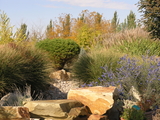
On July 15, 2015 California approved revisions to the Model Water Efficient Landscape Ordinance (MWELO), which promotes efficient water use in new and retrofitted landscapes. The following is a summary of the Ordinance:
One major change is new requirements for compost and mulch. To improve soil health and increase water retention, at least four cubic yards of compost per 1,000 sq. ft of area must be incorporated into the soil. At least three inches of mulch must be applied to all exposed soil surfaces in planting areas.
Other significant changes include:
1. Landscape Size Threshold
As of December 1, 2015, the Ordinance will apply to new landscape projects equal to or greater than 500 sq. ft. (the previous threshold was 2,500 sq. ft.). The Ordinance also applies to rehabilitated landscape projects equal to or greater than 2,500 sq. ft. A prescriptive checklist is available as a compliance option for projects under 2,500 sq. ft.
The following restrictions, including but not limited to the following, as well as irrigation system restrictions, apply to projects using the prescriptive checklist:
- Compost: Project must incorporate compost at a rate of at least four (4) cubic yards per 1,000 sq. ft. to a depth of 6 inches into landscape area (unless contra-indicated by a soil test).
- Plant Water Use (Residential): Install climate adapted plants that require occasional, little or no summer water (average WUCOLS plant factor 0.3) for 75% of the plant area excluding edibles and areas using recycled water. Plant Use (Non-Residential): Install climate adapted plants that require occasional, little or no summer water (average WUCOLS plant factor 0.3) for 100% of the plant area excluding edibles and areas using recycled water.
- Mulch: A minimum 3-inch layer of mulch should be applied on all exposed soil surfaces of planting areas, except in areas of turf or creeping or rooting groundcovers.
- Turf: Total turf area shall not exceed 25% of the landscape area. Turf is not allowed in non-residential projects. Turf (if utilized) is limited to slopes not exceeding 25% and is not used in parkways less than 10 feet in width. Turf, if utilized in parkways is irrigated by sub-surface irrigation or other technology that prevents overspray or runoff. Turf is not allowed in non-residential projects.
Landscape Water Meter Requirement: Landscape water meters, defined as either a dedicated water service meter or private submeter, shall be installed for all non-residential irrigated landscapes of 1,000 sq. ft. but not more than 5,000 sq.ft. (the level at which Water Code 535 applies) and residential irrigated landscapes of 5,000 sq. ft. or greater. A landscape water meter may be either: 1) a customer service meter dedicated to landscape use provided by the local water purveyor; or a privately owned meter or submeter.
2. Water Features such as Pools and Spas
Please note the surface area of water features, including ponds, lakes, waterfalls, fountains, artificial streams, spas, and swimming pools (where water is artificially supplied), is included in the high water use hydrozone of the landscape area.
3. Graywater for Irrigation
The ordinance encourages graywater use.
4. Irrigated Plants in Bio-Retention Basins/Bio-Swales
Plants in bioswales/bioretention basins would are not exempt from WELO. Plants in these drainage systems are regulated for their 'stormwater treatment' abilities, so to the extent possible, plants should comply with this approved list:
See Appendix A for Plant List: https://www.flowstobay.org/newdevelopment#c3TechGuidance
- Please see “water needs” column to pick the appropriate plants to meet WELO and stormwater water treatment needs.
Learn more at stopwaste.org.
Regulations
Water Efficient Landscape Ordinance
Forms
For Prescriptive Compliance
MWELO Project Information Short Form for Prescriptive Compliance
MWELO Prescriptive Submittal Checklist
Forms for Performance Approach
MWELO Sample Water Efficient Landscape Worksheet
MWELO Performance Submittal Checklist
MWELO Water Efficient Landscape Worksheet
Forms Due at Building Permit Final Inspection